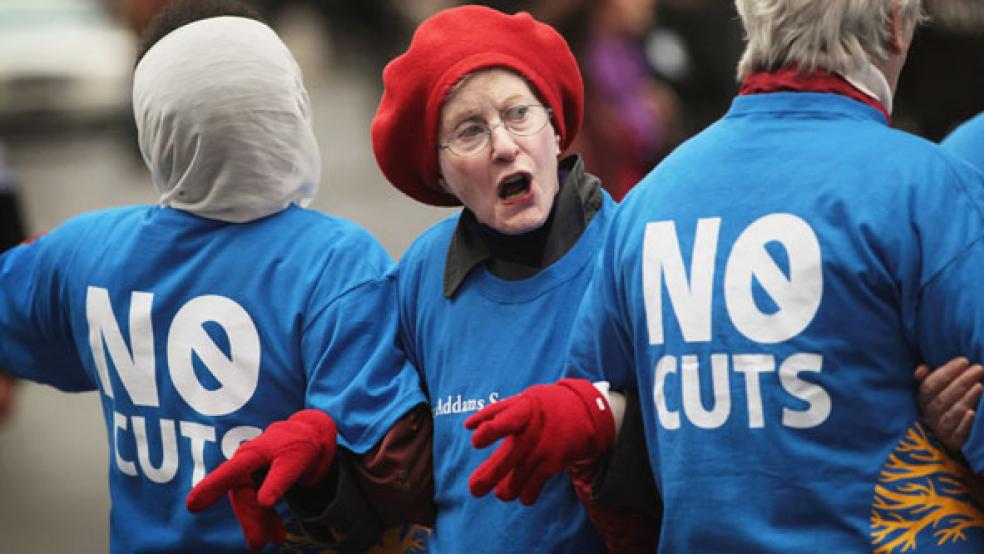With Medicare cuts on the Super Committee’s agenda, lobbyists and advocates are scrambling to ensure that seniors’ benefits don’t end up on the Thanksgiving chopping block.
The Congressional Budget Office last spring came up with a menu of options for generating savings in the national health care program for the elderly, which the Super Committee could use to help meet its goal of $1.2 trillion of deficit reduction by 2021. The proposals fall into two baskets: They either shift costs onto beneficiaries or cut payments to providers.
If the 12-member bi-partisan committee fails to come up with a plan, an automatic 2 percent across-the-board cut in Medicare provider payments will go into effect starting in 2013 as part of so-called sequestration. Such cuts would slash about $123 billion from federal spending, Medicare’s share of the sequestration.
But there are many other ways to achieve the same level of savings, CBO said. They include:
• Requiring drug companies to charge low-income seniors on Medicare’s Part D drug plan the same prices they charge Medicaid patients, which by law must be the lowest available price. Savings: $112 billion.
• Gradually increasing the premium seniors pay for physician services, now set at 25 percent, to 35 percent. If done for all Medicare beneficiaries, the increase would raise $241 billion over a decade.
• Gradually increasing the Medicare eligibility age from 65 to 67. Savings: $125 billion.
• Adopting a smorgasbord of changes to the program that would mostly affect providers, such as reducing Medicare’s subsidy to medical schools ($69 billion), limiting reimbursement rates in high-cost areas like south Florida ($48 billion), and bringing rural and Medicare-dependent hospitals into the existing cost control system ($62 billion).
The Obama administration in its September deficit-reduction plan included several of those approaches. But the administration made lower-priced drugs for many low-income seniors the centerpiece of its Medicare cost-reduction program. Those seniors had lower-cost drug coverage provided by Medicaid before the drug benefit went into effect on January 1, 2006.
That proposal has already generated a firestorm of opposition from the pharmaceutical industry, which has been making its case to Super Committee members. The Pharmaceutical Research and Manufacturers of America (PhRMA) claims the Medicare drug benefit, which is run through insurance companies, is already 41 percent below the initial projections for the program, and the average monthly premium for drug coverage is slated to fall slightly next year.
“These continued low premiums and below projected overall costs add to the overwhelming body of evidence demonstrating the competitive market structure of Part D is yielding great value for beneficiaries and the Medicare system,” PhRMA vice president Matt Bennett said in a prepared statement. “Policy proposals such as imposing mandatory rebates in Part D could fundamentally alter the successful program and lead to job losses.”
The drug industry wages an aggressive lobbying effort in Washington. The Pfizer pharmaceutical company’s political action committee was among the 19 industry groups that contributed a total of $83,000 to members of the Super Committee in the three weeks after they were appointed. Pfizer’s gave $10,000, the largest single contribution, according to the non-profit Sunlight Foundation.
Advocates for low-income seniors strongly prefer the administration’s plan for lowering the drug costs to raising premiums on beneficiaries or cutting other services. “We think it’s a fine proposal,” said Paul Van de Water, a senior fellow at the Center for Budget and Policy Priorities. “It returns things to the way they were before” the drug benefit went into effect.
Ron Pollack, executive director of Families USA, which coordinates the national network of grass roots advocacy groups that pushed for health care reform, is leading the charge along with AARP against making Medicare beneficiaries absorb the brunt of the cuts. “Most of those proposals are cost shifting, they’re not really cost savings,” he said.
For instance, raising the eligibility age to 67 will force 65- and 66-year-olds to seek private insurance. Many will simply decide to work longer to keep their employer-based coverage, whose costs will rise since older people are the most expensive to cover.
If employers choose to get rid of their older workers because of the impact it will have on their insurance rates, the next option for these near-old workers will be to buy individual insurance plans. Those plans are the most expensive in the marketplace.
And, as Pollack pointed out, if seniors seeking individual plans earn less than 200 percent of the poverty rate, which will be about half of the newly retired, they will qualify for subsidies under the recently enacted health care reform law, assuming it goes into effect. Since the federal government will pay for most of those subsidies through Medicaid, the net effect of raising the eligibility for those seniors will be to shift the subsidy from one federal pocket, Medicare, to another, Medicaid, which is exempt from the looming sequestration cuts.
Some senior and low-income advocates are open to further means testing of Medicare benefits. The program already charges higher premiums for Part B physician coverage if individual seniors earn over $80,000 a year or families make more than $160,000 annually The Obama administration has proposed lowering those thresholds so about a third of seniors get hit with the higher premiums, up from about 5 percent now. But that would only raise about $20 billion over the next decade.
“It’s possible to provide protections to low-income people,” Van de Water said, “but it wouldn’t save as much money.”





